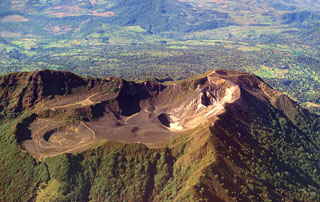Report on Turrialba (Costa Rica) — January 1983
Scientific Event Alert Network Bulletin, vol. 8, no. 1 (January 1983)
Managing Editor: Lindsay McClelland.
Turrialba (Costa Rica) Temperature and gas data
Please cite this report as:
Global Volcanism Program, 1983. Report on Turrialba (Costa Rica) (McClelland, L., ed.). Scientific Event Alert Network Bulletin, 8:1. Smithsonian Institution. https://doi.org/10.5479/si.GVP.SEAN198301-345070
Turrialba
Costa Rica
10.025°N, 83.767°W; summit elev. 3340 m
All times are local (unless otherwise noted)
Between 5 December and 20 December, 1982, a team from PIRPSEV (CNRS) and a volcanological team from the Universidad Nacional de Costa Rica sampled gases from Turrialba (table 1).
Table 1. Average values of gas compositions collected between 5 and 20 December 1982 compared to earlier data.
| Year | SO2% | CO2% | H2% | H2S% | CO% | CH4% | He ppm |
| 1981 | 0.016 | 99.95 | 0.022 | 0.003 | 0.001 | 0 | 4.7 |
| 1982 | 0.018 | 99.93 | 0.047 | 0.008 | 0 | 0 | 1.7 |
Geological Summary. Turrialba, the easternmost of Costa Rica's Holocene volcanoes, is a large vegetated basaltic-to-dacitic stratovolcano located across a broad saddle NE of Irazú volcano overlooking the city of Cartago. The massive edifice covers an area of 500 km2. Three well-defined craters occur at the upper SW end of a broad 800 x 2200 m summit depression that is breached to the NE. Most activity originated from the summit vent complex, but two pyroclastic cones are located on the SW flank. Five major explosive eruptions have occurred during the past 3500 years. A series of explosive eruptions during the 19th century were sometimes accompanied by pyroclastic flows. Fumarolic activity continues at the central and SW summit craters.
Information Contacts: J. Cheminée, IPG, Paris; M. Javoy and H. Delorme, Univ. de Paris.

